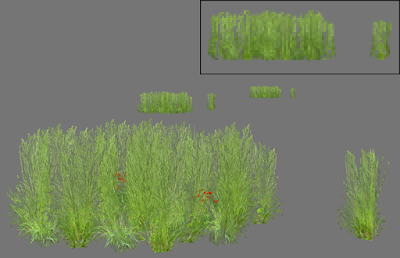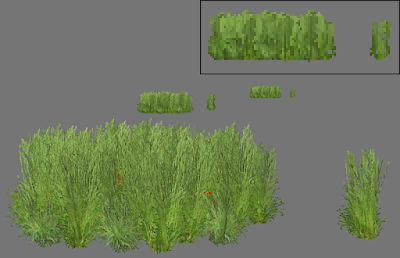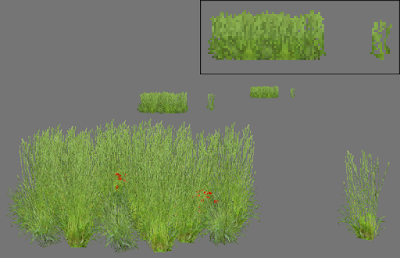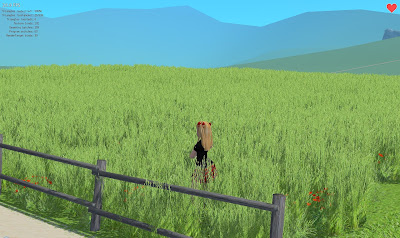If rendering foliage on has two options:
- Render it in opaque pass, using alpha test to discard transparent pixels
- Render it in transparent pass, using true alpha blending
Alpha blending gives the best results but kills your rendering performance very quickly. First - the blending itself is much more fillrate intensive operation than opaque rendering. Second - you cannot use deferred rendering. And third - you have to sort polygons.
Here is the transparent pass render of small test scene, as a reference:
 |
| A patch of Dactylis glomerata, rendered in transparent pass |
Even small patch of forest or meadow will have tens of thousands of
polygons. Something like realistic landscape simply is not doable using
transparency on current generation hardware.
This leaves us with the other option - opaque rendering.
While writing foliage shaders for Shinya the biggest problem was,
that scaled down textures (i.e. higher mipmap levels) looked totally
crappy. Whatever was the original shape of plant - looking at it from
distance it morphed into rounded blob.
The reason for it was the
minimization algorithm, that averaged alpha. Thus the parts of foliage
where there were only few "holes" - i.e. central parts - became
completely opaque. And the parts, where there were only few leaves -
i.e. outer regions - became fully transparent.
The "original" opaque render, using default mipmap generation (box filer):
 |
| The same image, rendered in opaque pass with box-filtered mipmaps |
While messing with textures and trying to find the best alpha
cutoff value, I finally got the right idea - we do not want to get the
average image but want to preserve "features" of image in minimization.
Features being both "holes" and "patches" (i.e. leaves). This can be
done by increasing high frequencies of image. I.e. we want to replace
the standard mipmap generation filter (normally box filter) with
something better.
Fortunately I was already composing mipmaps by
hand while creating packed textures. Thus I added very simple
edge-detection filter with 3x3 kernel to the foliage mipmap generation (after the minimization with box filer). And the results were really good.
The "enhanced" opaque render with edge detection filter:
 |
| The same image, rendered in opaque pass with edge-detection filter |
As you can see, edge detection successfully preserves the general features of the texture - stems and narrow leaves, while simple box filter tends to smear these out.
The kernel for edge-detection was:
-1 -1 -1
-1 9 -1
-1 -1 -1
And here is a screenshot of the foliage shader in action. The meadow size is about 40x40 meters, grass is about 50000 instanced polygons.
 |
| Sara in meadow |
You can download the
Dactylis glomerata texture from my
DeviantArt gallery.
Have fun!




